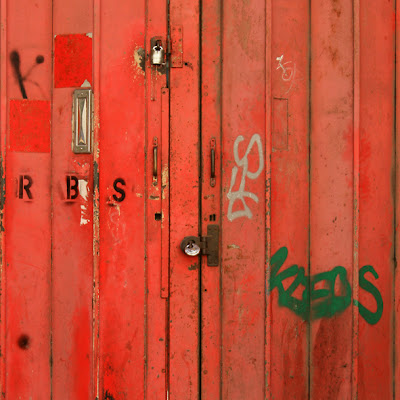Previously, this blog has only showcased my own paintings in their finished state, describing their production in the past tense. This time I’ll capitalise on the ongoing journal nature of a blog to give some insights into work that’s in progress and a glimpse of it in the studio.
 |
| 'Closed 1' In Progress (Earlier Today) |
I expressed frustration over how long it took to complete my ‘Sick 1’ quartet and having seen it off, it seemed important to complete something else more rapidly if possible. Working speed can be a problem for me and too often I’ve lost direction, sinking into over-analysis and eventual stasis. I could have won multiple awards for procrastination over the years. I’m sure most artists would agree that maintaining creative momentum is easier than getting the boulder rolling again after it’s come to rest and last year’s steady output bore that out for me. Happily, I had a clear idea for my current piece(s) and am making good progress as I write - halfway through the Easter holiday. Essentially, this post is about keeping a wiggle on.
One afternoon in August 2007 I took my camera into central Leicester and found a set of firmly closed brilliant red industrial shutters. I was instantly drawn to the wealth of visual incident within a single colour field. Within vertical structural divisions occur multiple chips, scrapes and scratches, accumulated dirt, faded paint and palimpsests of original colour. Formal and semi formal lettering, unofficial graffiti and scattered door furniture punctuate the corrugated surface further. The photos I took stand as images in their own right but I’ve always wondered if they’d work as larger paintings. The original red images were since augmented with shots of a similar blue subject taken two years ago.
 |
| 'Closed': Photographic Source Images |
Our ongoing economic dilemmas mean the media agonise endlessly over the travails of businesses to survive or prosper within a dysfunctional economic model. In addition, ever more avenues of opportunity are shut off - for employment, education good health or a safety net for the most vulnerable. If any sense of a secure future is offered, it is defined in ever-narrower terms. Those who’ve annexed wealth or privilege guard it jealously to the exclusion of the majority. ‘Closed’ seems an appropriate descriptor of the current situation. In that context, the motif of shutters drawn and locked against the world seems ripe for exploitation.
 |
| 'Closed': Sketchbook Studies |
As usual, I’ve done much of the planning through heavily worked sketchbook studies. The finished appearance of these hides multiple development stages below the surface. I’ve stayed close to the source images, slightly abstracting them within the basic format of broad and narrow parallel vertical bands. I’ve also remained faithful to the saturated palette of the originals and will probably embark on a blue variant when the current one is complete. It’s all closely related to my work from last year but also reveals older enthusiasms for formal abstraction and Modernist colour field painting. There are nods to the variation within mono-colour and ‘all-overness’ of Robert Ryman and formal banded geometry of early Stella here amongst other influences.
 |
Robert Ryman, 'Catalyst III', Enamel
On Aluminium with Bolts, 1985 |
 |
Robert Ryman, 'Untitled', Pencil & Oil
On Paper, 1958 |
 |
Frank Stella, 'Six Mile Bottom', Aluminium
Paint On Shaped Canvas, 1960 |
Currently, the biggest unknown with 'Closed 1' is the exact content and treatment of the subsidiary text. Possible phrases include ‘Capital’, ‘Market Imperatives’, and ‘In The Marketplace’ and I’ll aim to distinguish between formal, semi-formal and outlaw text styles as usual.
I’ll be addressing all that by the time you read this…
























































